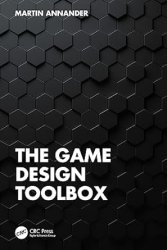The Game Design Toolbox
- Добавил: literator
- Дата: 4-10-2023, 22:11
- Комментариев: 0
 Название: The Game Design Toolbox
Название: The Game Design ToolboxАвтор: Martin Annander
Издательство: CRC Press
Год: 2024
Страниц: 191
Язык: английский
Формат: pdf (true)
Размер: 15.8 MB
This book presents 71 practical game design tools that readers can use to solve real-world game design problems. Written to be a "toolbox" for game designers, it offers a hands-on approach with clear and easy-to-use tools so that readers can quickly find the right solution to the problem they are facing.
This book is divided into six game design phases: ideation, exploration, commitment, problem solving, balancing, and tuning. Each category contains an array of relevant tools, and the accompanying indexes offer suggestions for tools to use for specific problems. Support Materials for this book offer further teaching materials, exercises, and complementary FAQs.
As a framework for the toolbox, we will use two informal templates just to have a working definition of what a game designer does for a living. This is not an attempt to define anything—it’s merely the framework for the tools in this book.
• The first relates to what game design is and serves to separate everyday discussions about games from the job of a game designer. It does this by dividing the role of a game designer into four separate levels, somewhat like the experience levels in a role-playing game.
• The second presents six stages of game design and acts as chapters for all the tools that form the bulk of this book. Each stage is a distinct part of the design process, even if they are rarely treated that way in practical scheduled reality.
The following tries to lay out the work and the responsibilities that come with game design in a practical way. If you’re making analog games—card games, board games, tabletop role-playing games, etc.—you’re more likely to work alone or in a small team. In digital game design, teams vary greatly in size from solo developers to giant cross-disciplinary studios distributed across multiple teams all over the globe. Team size changes the dynamic of the work, but it doesn’t really change the work. It does lead to specialization, however. In a really big team, you may be entirely focused on a very small part of the design puzzle and never touch the other parts. But for the sake of this framework, we’ll look at game design holistically. Just remember that it won’t always be your responsibility to do everything.
Written to be a practical resource, this book will be a useful toolbox for junior and veteran game designers alike.
Скачать The Game Design Toolbox
[related-news] [/related-news]
Внимание
Уважаемый посетитель, Вы зашли на сайт как незарегистрированный пользователь.
Мы рекомендуем Вам зарегистрироваться либо войти на сайт под своим именем.
Уважаемый посетитель, Вы зашли на сайт как незарегистрированный пользователь.
Мы рекомендуем Вам зарегистрироваться либо войти на сайт под своим именем.
